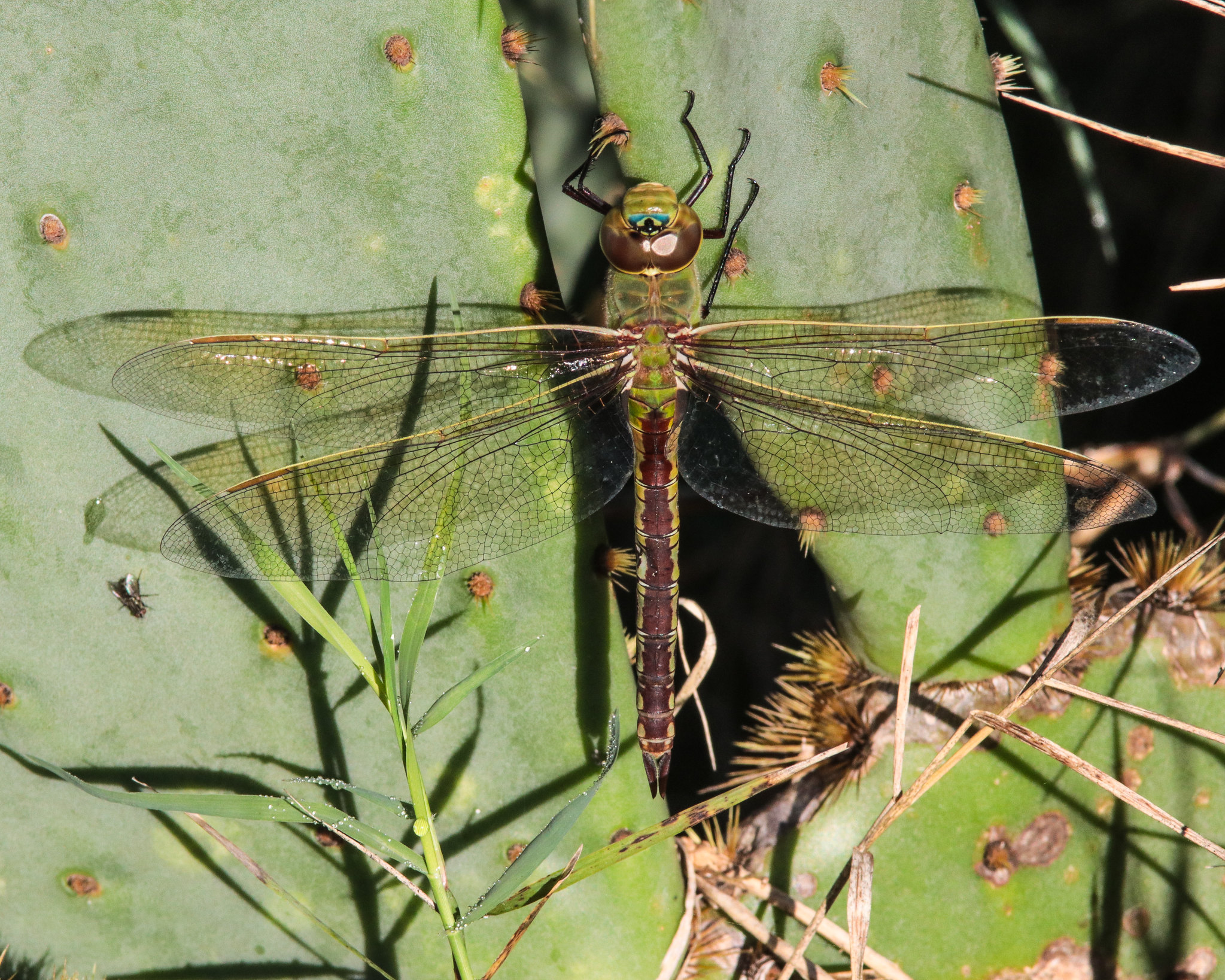Dragonflies in TexasPart II
Nov 1, 2021 18:19:43 #
The most common dragonfly I saw while surveying in the Austin area was the Anax junius or "Ajs" as we sometimes refer to them. Anax is a genus of Green Darners. They are a rather large species coming in at about 3 inches and the wingspan just slightly greater. The name Common Green Darner is quite apropos. It's range is lower Canada the US down to Panama. They are one of the migrating species. What is different about it is there are also local species that hatch, spend a few years as a naiad, emerge mate, live out their life and die in an area close to their emergence. Others emerge and migrate northward in early spring and can be seen as one of the earliest species of the season. During bird migrations large swarms of these darners can be seen in the flyway.
The coloration you see in my pics is common of mature adults of the species.
 Common Green Darner (Anax junius) M by Tony Schoch, on Flickr
Common Green Darner (Anax junius) M by Tony Schoch, on Flickr
 Common Green Darner (Anax junius) F by Tony Schoch, on Flickr
Common Green Darner (Anax junius) F by Tony Schoch, on Flickr
Another Dragonfly in the family Aeshnidae (Darners) is the Comet Darner. I was very fortunate to find this one perched high up in a tree. I have seen them patrolling but never perched. The Comet Darner is considered a tropical species and the center of its North American distribution lies in southern Kentucky. It ranges north to New Brunswick, south to Cuba and west to Texas and Wisconsin. Sometimes in different stages of maturity they can be difficult to distinguish from the Common Green Darners. But if you look very closely at the frons (forehead) of the Ajs you can see what is called the "bullseye." In the following picture of the male Comet Darner (Anax longipes) you can see it is not present.
 Comet Darner (Anax obscurus) M by Tony Schoch, on Flickr
Comet Darner (Anax obscurus) M by Tony Schoch, on Flickr
The long thin abdomen is the reason for the name darner as it resembles a darning needle.
Enjoy. More to come.
>i< Doc
The coloration you see in my pics is common of mature adults of the species.
 Common Green Darner (Anax junius) M by Tony Schoch, on Flickr
Common Green Darner (Anax junius) M by Tony Schoch, on Flickr Common Green Darner (Anax junius) F by Tony Schoch, on Flickr
Common Green Darner (Anax junius) F by Tony Schoch, on FlickrAnother Dragonfly in the family Aeshnidae (Darners) is the Comet Darner. I was very fortunate to find this one perched high up in a tree. I have seen them patrolling but never perched. The Comet Darner is considered a tropical species and the center of its North American distribution lies in southern Kentucky. It ranges north to New Brunswick, south to Cuba and west to Texas and Wisconsin. Sometimes in different stages of maturity they can be difficult to distinguish from the Common Green Darners. But if you look very closely at the frons (forehead) of the Ajs you can see what is called the "bullseye." In the following picture of the male Comet Darner (Anax longipes) you can see it is not present.
 Comet Darner (Anax obscurus) M by Tony Schoch, on Flickr
Comet Darner (Anax obscurus) M by Tony Schoch, on Flickr The long thin abdomen is the reason for the name darner as it resembles a darning needle.
Enjoy. More to come.
>i< Doc
Nov 1, 2021 18:28:23 #
Nov 1, 2021 18:29:12 #
Nov 1, 2021 18:33:33 #
docshark wrote:
The most common dragonfly I saw while surveying in... (show quote)
Fantastic set of images Doc
Nov 1, 2021 18:34:20 #
Nov 1, 2021 18:52:14 #
quixdraw wrote:
Excellent photos and info as always! Thanks, Doc!
So glad you enjoyed them and the narrative. It was a great trip.
>i< Doc
Nov 1, 2021 18:55:38 #
JeffDavidson wrote:
Beautifully captured
I appreciate that Jeff. So glad you enjoyed. >i< Doc
Nov 1, 2021 19:03:11 #
Nov 1, 2021 19:10:34 #
Nov 1, 2021 19:15:34 #
Manglesphoto wrote:
Fantastic set of images Doc
Hey thanks Frank. So glad you enjoyed them. I always appreciate your comments.
>i< Doc
Nov 1, 2021 19:24:47 #
Nov 1, 2021 19:40:50 #
kpmac wrote:
Outstanding again, Doc. That last one has some wear on it.
Hey Ken I'm glad you enjoyed them and took the time to comment. Talk about wear, check this Aj out from a Texas survey a few years back. He flew just fine!!
>i< Doc
 Common Green Darner (Anax junius) F by Tony Schoch, on Flickr
Common Green Darner (Anax junius) F by Tony Schoch, on FlickrNov 1, 2021 19:43:27 #
Nov 1, 2021 19:45:29 #
UTMike wrote:
All these excellent photos and grandchildren to boot, good work, Doc!
Yes Mike and it was as good a trip as I could have imagined. Thanks for the fine comment my friend.
>i< Doc
Nov 1, 2021 19:49:30 #
imagemeister wrote:
Very NICE work and info ! .......thanks for sharing
I appreciate that Larry. Glad you enjoyed the narrative. I always wonder if people want to hear about the dragons or just want to look at the pictures.
>i< Doc
If you want to reply, then register here. Registration is free and your account is created instantly, so you can post right away.








